The Latest from TechCrunch |  |
| In Quest For Real Revenue From Virtual Goods, hi5 Teams Up With PlaySpan Posted: 14 Apr 2009 07:00 AM PDT
Two of PlaySpan’s payment solutions will be used (PayByCash and Ultimate Game Card), getting the most out of the variety of payment methods used across the globe, which is essential for hi5 since the large majority of its users are located outside the U.S (about 40% speaks Spanish, for example). The company’s subsidiary PayByCash is able to support approximately 80 payment methods in 180 countries and boasts an extremely low fraud rate, and the addition of hi5 to its customer reference list further validates the alternative micro-payment platform. Hi5 will also offer its subscriber base the ability to buy and use PlaySpan’s Ultimate Game Card, a pre-paid game card available for purchase online and in more than 21,000 retail stores across the U.S. and Canada (and apparently soon expanding to other countries). For actual transactions on the social network, the company continues to bet on hi5 Coins (which can now be paid with using PayByCash), a virtual currency it launched late last year, which I’ve personally always considered a strange move considering it requires users to get accustomed to using a currency that can’t be used for anything else outside of the network while standard ‘gift credits’ seem to work just as well.
Either way, the company is clearly trying to ramp up its revenue streams, recently launching a casual gaming section which hi5 said would prove very important for making money in the long run, and partnering with Paymo to power mobile payments for virtual goods. The partnership with PlaySpan once again shows that monetization through anything but advertising is the key focus over at hi5, and recent reports show that that may be the best strategy worth pursuing. You may remember Habbo, which we reported pulled in $74 million in revenues last year, mostly from virtual goods, or the market analysis on Chinese social networks, whose business models have long relied mostly on sales of virtual gifts rather than online advertising. Expect to see more of these reports in the future. Finally, it’s also worth noting that hi5 has been on a cost-cutting spree, recently slashing an estimated 50% of its workforce. Crunch Network: CrunchGear drool over the sexiest new gadgets and hardware. |
| Dive Into The Five Great Lakes With Google Earth Posted: 14 Apr 2009 06:58 AM PDT
The NOAA Great Lakes Environmental Research Laboratory has assembled a narrated Google Earth tour, which you can download here. Or you can just check out the Google Gadget embedded in the blog post announcing the addition of the Great Lakes to Google Earth (requires the Google Earth API). Let us know if you find the lost City of Atlantis in those lakes somewhere. Crunch Network: CrunchBase the free database of technology companies, people, and investors |
| App Management System ExtraHop Scores $5.1 Million In Series A Funding Posted: 14 Apr 2009 06:53 AM PDT
Founded in 2007 by former engineers from F5 Networks, Extrahop uses fluctuations in switch and processing capacity to analyze all the traffic within in an application. The software also lets engineers monitor apps and manage issues with troubleshooting. Extrahop says that it will use the funding to fund investments in customer acquisition, product development, and go-to-market efforts. Competitors that manage apps for businesses include NetQOS and NetScout. Crunch Network: MobileCrunch Mobile Gadgets and Applications, Delivered Daily. |
| Syndicaster Adds AOL, Brightcove, And YouTube Distribution For Local TV News Clips Posted: 14 Apr 2009 06:48 AM PDT
Continuing its quest to bridge the world’s of broadcast television and the Web, Syndicaster is adding several online distribution options for local TV stations, including the ability to publish video clips to YouTube, AOL (via Brightcove), Yahoo and other sites. Syndicaster is an online editing and video-clip management service that allows TV stations to any broadcast news clip and repurpose it for the Web by publishing it to their own Websites or through its sister service ClipSyndicate (both Syndicaster and ClipSyndicate are divisions of Critical Media). Now Syndicaster is adding one-click distribution options to the major video sites so that local TV affiliates or station groups can post their videos to AOL Money & Finance or their YouTube channel, and manage it all from one place. One feature that TV customers will appreciate is the ability to set embargo windows for each service, allowing a TV station to publish hot news immediately to its own site, then 24 or 36 hours later to video partner sites where it makes the most money, and then maybe finally to YouTube. Syndicaster has also recently added an on-location feature which allows TV reporters and crews to upload clips directly from wherever they are capturing the footage, and making that footage available as Web video clips even if it never gets airtime. Affiliated stations can also go to Syndicaster to find footage and use it either on the Web or on-air, depending on their arrangements with each other. When that airplane crashed in Buffalo, NY recently, a local station put all of its footage on Syndicaster, and other affiliated stations around the country used it to grab video footage for their own on-air reports. Syndicaster charges a flat subscription fee of about $850 a month per TV station or news organization. With 60 paying customers, that comes to about $50,000 a month a few months after launch, with a lot of runway for growth. Syndicaster is exploring ways to bring its online editing and video distribution platform to consumers, but so far it is stumped in that area. CEO Sean Morgan admits:
In May, the company plans to expand its reach to newspaper sites with Syndicaster for Newspapers. As news organizations of all stripes make video a bigger component of their online offerings, Syndicaster is hoping to become the industry standard for ingesting, editing, and distributing these videos. Maybe the A.P. should look into it. Crunch Network: CrunchGear drool over the sexiest new gadgets and hardware. |
| Backblaze’s Online Backup Solution For Macs Hits Public Beta Stage Posted: 14 Apr 2009 05:56 AM PDT
Backblaze, available in 11 languages, costs $5 a month or $50 a year for unlimited online storage for backing up your hard drive, with a 15-day free trial available. The service continuously monitors files for changes and uploads them to the server, and in the event of a hard drive failure allows users to selectively download files via a web interface or have them delivered on DVDs or a USB drive. Backblaze puts the emphasis on simplicity, allowing users to begin backing up in only a few button clicks with a minimal amount of setup (though it does have advanced features - they're just hidden by default). Other online backup services include SugarSync, Mozy, iDrive and Carbonite (and yes, we know there are many many more). On a sidenote: both Blackblaze’s CTO and its VP of Engineering previously held senior technical positions at Apple, so that should lend it quite a bit of credibility. Until something goes wrong of course, which it almost always does (multiple backups = must). Mac users, check out Backblaze and let us know how your tests go. Crunch Network: CrunchBoard because it’s time for you to find a new Job2.0 |
| NileGuide Wants To Be Your Personalized Travel Agent And Concierge Posted: 14 Apr 2009 05:53 AM PDT 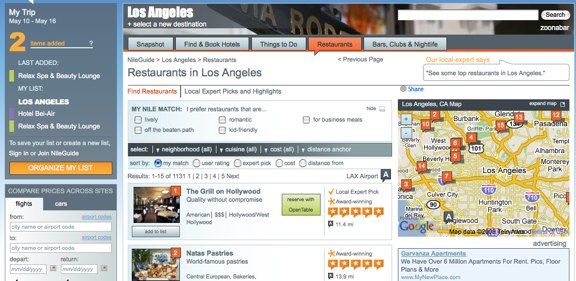 NileGuide, a one-stop travel planning site, is rolling out several new features to its travel booking and planning portal. You can see our original review of the site here. NileGuide has re-designed the site with a sleek interface, a few more bells and whistles, added more geographic coverage areas, and created several trip planning tools to enhance the planning process.
The layout and general concept of the site has remained the same but Nile Guide has added more graphic imagery and high quality photos of destinations to add to the aesthetics of the site. It has also added 20 more destinations, so that it now includes customized, in-depth information for 100 destinations worldwide. Like the original version of the site, NileGuide aggregates information about destinations from over 10 sources, including Citysearch, OpenTable, Priceline, and Expedia, as well as adding its reviews from local experts who are familiar with the area. Now NileGuide has “suggested itineraries” for each destination. And NileGuide is tapping into the powerful consumer review site Yelp for consumer reviews of hotels, restaurants, and bars. With all of this information, NileGuide has created neighborhood guides for various neighborhoods within each destination (much like CitySearch does). The site has interactive maps with the top destinations in each neighborhood. With NileGuide’s search filters, you can easily choose the right spot for any occasion, with options such as “price,” “kid-friendly,” hip,” and “upscale.” NileGuide has also added a search widget comparison tool that lets you search and compare prices for both flights and cars via Priceline, Kayak, Hotwire, and Orbitz. The hotel search feature now injects real-time pricing availability powered by Priceline’s API. NileGuide lets you book your hotel directly through its site and offers comparison prices from Expedia.
Each selection, whether it be hotel, flight, restaurant, event, or bar can be dragged and dropped into the virtual itinerary, which at the end of the trip planning process can be converted into a handy PDF file (that can be emailed or printed), complete with all the necessary information, pictures and maps. As we said in our original post on NileGuide, the site wants to be way more than a travel planning site and this makeover reinforces this ambition. The consumer and expert reviews combined with the ability to book flights and cars truly make it more of a one-stop-shop than its previous version. The travel search, planning and booking space is chock full of sites doing similar things—TripAdvisor also helps create itineraries but NileGuide’s new features and search capabilities go further. Zicasso and Offbeat Guides and TripWolf also assist consumers in the online travel planning process. Founded in 2006 and based in San Francisco, NileGuide has received $9.5 million in funding from investors including Draper Richards, KPG Ventures, Austin Ventures, and Tenaya Capital. Crunch Network: CrunchBase the free database of technology companies, people, and investors |
| Visible Measures Now Tracking Videos At MySpace Posted: 14 Apr 2009 05:32 AM PDT Video tracking startup Visible Measures signed up MySpace as a customer to measure more deeply how consumers are watching and spreading videos from the site. MySpace is the Web’s No. 2 video site, although it is still only one tenth the size of YouTube in terms of videos streamed. Visible Measures, which raised $10 million in March in a series C funding, also counts Viacom and MTV Networks as another big customer. Like every other video site, MySpace is increasing the amount of professionally-produced premium videos because those are more appealing to advertisers. It sees the user-generated videos (UGC) more as a communication feature for MySpace members. MySpace’s video VP Jason Kirk tells me: We have seen big increases in premium intent viewing over UGC. Premium content views probably close to doubled in the last year. USG video is part of the social network part of our site. With Visible Measures, MySpace will be able to track consumer engagement at a more granular level. And, more importantly, it can give all of its video partners a self-serve dashboard to track their own videos. For instance, they will be able to see how many times a particular video is watched 10 percent through, 60 percent through, or all the way through. Visible Measures also tracks views as they spread across the Web and can show spikes based on what other sites pick up a particular video. Visible Measures CEO Brian Shin was surprised the amount of premium video content available on MySpace and the engagement levels he’s seen so far. According to him, the average viewing time per session on MySpace is 10 minutes, with the average viewer watching four videos per session. He says that is “twice the norm” for comparable videos on other sites. In contrast, Comscore’s VideoMetrix, which doesn’t directly measure each video but is rather an estimate based on a panel, shows only 11.3 minutes watched per viewer per month for Fox Interactive as a whole. Crunch Network: MobileCrunch Mobile Gadgets and Applications, Delivered Daily. |
| Microsoft PubCenter Producing Strong Results Via YieldBuild Online Ad Planning Program Posted: 14 Apr 2009 05:00 AM PDT
Microsoft PubCenter, Microsoft’s competitor to Google’s AdSense and Yahoo’s Publisher Network, is being beta tested through ad network and layout optimization service, YieldBuild, and receiving positive results. We recently wrote about the encouraging reports we received from beta testers of PubCenter, which is a a self serve third party ad publishers platform similar to AdSense and Publisher Network. YieldBuild is launching a new program for publishers which provides premium text ads to websites using Microsoft PubCenter (which is part of Microsoft’s AdCenter) as the source of high-quality text ads to run alongside existing text and display ads. YieldBuild uses computer algorithms to automatically optimize a website's ad spots with the most profitable combination of ad layout, style, and network. What’s interesting is that YieldBuild’s beta testers of the new text ad program with PubCenter ads have seen improvements of over 100% in effective CPM rates for clients, according to the company. But Paul Edmondson, CEO of YieldBuild says that the optimal ad plan for publishers is to have a mix of AdSense and and PubCenter ads on their sites because both networks are highly complementary to each other. Some of the publishers who have tested the program already have AdSense ads, so the PubCenter ads are integrated with the AdSense ads. Edmondson says that the addition of PubCenter Ads increases publisher CPM rates across the board, with one publisher increasing the CPM rate by more than ten times. Now qualified publishers have a back door to start using PubCenter Ads, which has been in private beta testing since last summer. Edmondson confirms that PubCenter is an incredibly strong ad network that rivals AdSense. Google has dominated this space in the past (and all other contextual advertising) because it offers publishers higher fees for ads. But this might change when Microsoft unveils PubCenter to the greater publisher community, particularly if Microsoft is aggressive in revenue splits to gain market share. And this is the second report of high quality ads and higher CPMs with PubCenter than with AdSense. As we said in our last post about PubCenter, we’ve heard that PubCenter is being tested by a small subset of web publishers and that one pilot publisher is receiving four times more in revenue from Microsoft than Google AdSense. Our source also said that PubCenter’s advertisements are higher quality than Google's ads and equally as targeted towards the content. We also heard that Microsoft is allowing publishers to get creative with ads by allowing them to set background images. Google AdSense only allows publishers to change the color of the ads. The YieldBuild partnership and beta results only seem to reinforce the strength of Microsoft’s PubCenter. And while they may be anecdotal, all signs point to a head-to-head competition between PubCenter and AdSense. Anyone want to take bets? Crunch Network: CrunchGear drool over the sexiest new gadgets and hardware. |
| HD Cloud Puts Video Formatting In The Cloud Posted: 14 Apr 2009 04:25 AM PDT
Producing and editing compelling video is only half the work involved in publishing video content to the web. Once finalized, video needs to be formatted and converted to the proper version, or transcoded, to adapt content to the proper format. Startup HD Cloud, a video encoding and transcoding business, wants to become the "the FedEx of web video" is offering automated, high-definition video encoding in the cloud for large-scale media firms. The SaaS allows video content owners to automatically encode and distribute videos, with HD resolution, to a range of web sites. HD Cloud has also already signed on a big name customer, Magnify.net, a video publishing platform and social network. HD Cloud’s services will be used to transcode videos for Magnify.net’s 52,000 enterprise clients, including Weather.com, New York Magazine, Zappos.tv, LiveEarth, and BlogHer.com. HD Cloud is part of the expanding trend of eliminating hardware services in favor of using server-based “cloud” services. In this case, the cloud server’s capacity helps clients run thousands of video encoding sessions at the same time. And HD Cloud then automatically distributes videos to a variety of desinations, including content management systems, local drives, and syndication sites. HD Cloud has other encoding services utilizing the cloud, including Encoding.com, which also offers a cost efficient and scalable encoding service that leverages cloud computing. . Crunch Network: MobileCrunch Mobile Gadgets and Applications, Delivered Daily. |
| Learn A Language, 10 Words At A Time Posted: 14 Apr 2009 04:20 AM PDT
Learn10 allows you to quickly pick up the basic vocabulary of a language by teaching you 10 words a day, wherever you are. English speakers and learners can choose to learn frequently used vocabulary of a language for free using Learn10’s content (coming from one of 22 language pairs) or opt to input their own content (subscription-based). It comes with a widget you can share on any website or blog, as well as a variety of social networks like Facebook, MySpace and Twitter. When you click through to a word on the Learn10 widget, it fetches some basic information about the word in question but also searches Twitter’s real-time stream so you can get a feel of how the word is used in a certain language. This is a small feature but a very good idea: sometimes context is exactly how you remember to use words and phrases in a foreign language correctly. Furthermore, a built-in, Flash-based avatar can be used to speak words to you, so you don’t only learn how to write but also how to pronounce them (only for paying subscribers). You can even record the way you speak words and share it with the Seesmic community in one click, so native speakers are able to correct (or compliment) you virtually in real-time. What else is there? Learn10 features a quick test you can kick off to check the state of your knowledge about basic vocabulary for a foreign language, and integrates with Google Translate so you don’t necessarily need to leave the site if you want to immerse yourself in another language a little deeper. The company also enables you to install a browser toolbar (powered by Conduit) and comes with a nifty screensaver, giving you the ability to keep the 10 words you’re supposed to be learning coming back to you multiple times a day in various ways (see Extras). Did we mention there’s also an API? Finally, paying users can consult their revision history and keep track of their progress. Learn10 also built an iPhone web app, available free of charge, that incorporates some of the features of the web version and allows you to learn vocab on the go, with the ability to test yourself while you’re at it. In the video interview I did with co-founder Mike Robinson, he shares more about the app (sorry about the fact that the screen isn’t always as clear as I would have liked it to be): Crunch Network: CrunchBoard because it’s time for you to find a new Job2.0 |
| StumbleUpon, A Case Study In The Efficient Allocation Of Resources Posted: 14 Apr 2009 03:11 AM PDT
You’d think that the founders (Garrett Camp, Geoff Smith and Justin LeFrance) would be quite content to go into semi-hibernation at eBay and contemplate their vacation homes for years to come. But like so many already-wealthy entrepreneurs, some fire kept driving at them to keep themselves challenged. It may be the deep rooted insecurity that leads most entrepreneurs to try to build companies in the first place - getting bought doesn’t necessarily give them the self confidence they thought it would. Or it may be a simpler explanation - the certain knowledge that StumbleUpon hasn’t yet become whatever it is eventually destined to be. So when the opportunity came for the founders to buy the company back from eBay and start over, they took it. The struggling eBay had been looking to sell off StumbleUpon for months, even hiring investment bank Deutsche Bank to help them get back their $75 million, but there were no takers. That left the door open for the founders to buy it back themselves. What’s next for StumbleUpon? Presumably Ebay got some cash in the deal from the injection of capital from the founders, Sherpalo Ventures, Accel Partners, and August Capital. Some of that new cash must also be used to capitalize the newly independent company. StumbleUpon has a revenue model that forces ads on users every few pages they view at a flat rate of $0.05 per ad, and since they have 100% click-throughs on the forced feeding of these ads, there is presumably some very real revenue flowing to the company. StumbleUpon doesn’t cost much to run. Remember that they only raised $1.5 million before the original sale, so keeping the lights on shouldn’t be a problem, even if growth continues to stagnate (in fact, Comscore shows StumbleUpon with the same number of unique monthly visitors today, 1.5 million, that they had two years ago). Growth will almost certainly kick in again now that the team has a renewed incentive to better the product and compete. StumbleUpon had terrific growth prior to the eBay sale (see chart); my guess is they’ll get healthy again soon. What I love about the spin off is that the company is now able to allocate resources properly, without having to deal with the bureaucracy of a huge public company parent to slow things down and drain off people and cash. There have been other examples of sales followed by buybacks in the past. My favorite is Webshots, which was sold to Excite for $82.5 million in 1999, bought back by the founders for $2.5 million in 2001, and then resold to CNET for $71 million in 2004 (CNET later sold it to American Greetings for $45 million in 2007). Listen to the first few minutes of this podcast with Narendra Rocherolle, one of the founders, for that story. It would have been different if eBay had integrated StumbleUpon into its core business somewhere along the way, or synergies between the products allowed StumbleUpon to shine in a way that it never could as an independent company (like YouTube has at Google). But none of that happened. So by far the best thing was for the company to once again fight it out as a small, nimble startup. Resources have been allocated efficiently, and the startup ecosystem is healthier for it. Crunch Network: MobileCrunch Mobile Gadgets and Applications, Delivered Daily. |
| Birdhouse: The CMS For Twitter You Don’t Need — But Watch The Video Posted: 14 Apr 2009 01:58 AM PDT
While Birdhouse dubs itself as a “notepad for Twitter,” upon using it, I think it’s more like WordPress for Twitter. The idea is extremely simple: You start it up and compose tweets that pop into your head. Birdhouse automatically saves these tweets in the “Drafts” folder, until you decide you’re ready to publish them. Anytime before you do that, you can edit them, assign a rating for how good you think they are (one to five stars) or delete them. Once you publish a tweet, it’s moved into your “History” folder. From here, if you click on a tweet, you can unpublish it from your Twitter stream. You can’t check other users’ tweets from Birdhouse, because that isn’t the point of the app. It really is just a content management system (CMS) for Twitter on the iPhone. Whether a format that is limited to 140 characters actually needs a CMS is another story. But it’s one that the guys from Sandwich Dynamics, the creators of the Birdhouse app, explain humorously, if not exactly well, in the video below. This app would have a lot more value if it allowed you to do timed tweets. That is, write a tweet and set it to publish at a certain time. The company hints that more features are on the way, hopefully that is one of them. For now, if you truly consider your tweets to be works of art that need refining (and I know some of you do), you may want to check out Birdhouse. It’s $3.99 in the App Store (iTunes link). If you just want a faster way to publish tweets, check out JustUpdate (iTunes link) — it lacks the CMS features, but it’s fast as hell, and free. [via Laughing Squid] Crunch Network: MobileCrunch Mobile Gadgets and Applications, Delivered Daily. |
| Will consumers line up for iPhone ]I[? Posted: 14 Apr 2009 01:21 AM PDT  As we approach the potential hour of power this June when Steve Jobs will come down from his mountain fortress bearing the new iPhone, this time with magnetometer and 3.2-megapixel camera or whatever, I keep wondering something: Will anyone buy it? Under a decade ago it wasn't unusual for folks to buy the latest Nokia - one after the other - simply because of the feature set offered by each subsequent model. In about 2002 or so, you'd see folks jumping from the black and white screen to the color screen to the VGA camera to the 1-megapixel to the pseudo-smartphone. Those days are gone. As we approach the potential hour of power this June when Steve Jobs will come down from his mountain fortress bearing the new iPhone, this time with magnetometer and 3.2-megapixel camera or whatever, I keep wondering something: Will anyone buy it? Under a decade ago it wasn't unusual for folks to buy the latest Nokia - one after the other - simply because of the feature set offered by each subsequent model. In about 2002 or so, you'd see folks jumping from the black and white screen to the color screen to the VGA camera to the 1-megapixel to the pseudo-smartphone. Those days are gone. |
| Android “Cupcake” Build Nearly Golden Brown Posted: 13 Apr 2009 08:00 PM PDT
Four months of discovery and hearsay later, the Android build that we’ve all been waiting for is nigh. Run inside, everyone - run inside and charge your G1s, for Cupcake (Firmware v1.5) is nearly upon us. (Actually, it’s still a few weeks away. But you should charge your G1 anyway, seeing as it’s a G1 and the day is halfway over, so the battery’s probably almost dead.)
The Android Developers Blog announced today the availability of an “early look” Android 1.5 SDK. This release seems like a mostly complete version of the final release, though Google warns that some of the APIs are bound to change. Beyond the features that v1.5 bring to the end user (see below), the new SDK carries a few key changes:
With Google releasing a preview version of the SDK (thus allowing developers to ensure their apps are in working order), it seems quite likely that Cupcake will start to roll out to the end user as soon as the final version of the SDK goes live - which should happen ” around the end of this month”. With the release approaching, the final feature list has been disclosed. Though anyone who’s kept an eye on our continued Android coverage should recognize most of the list, a few tidbits manage to sneak in under the radar. The Highlights:
Want to read the full list? Check it out here. Crunch Network: MobileCrunch Mobile Gadgets and Applications, Delivered Daily. |
| MySpace ‘Lite’ Brings Bloated Profile Pages Down To Size Posted: 13 Apr 2009 07:23 PM PDT MySpace users have been noticing a new button in their Nav Bars this afternoon, allowing them to switch between the site’s traditional ‘Full’ view and a new view, called ‘Lite’, which strips out the customization and media that the site’s profiles have become known for. When reached for comment, MySpace confirmed that they have been quietly testing the ‘Lite’ feature in the US today, explaining that the product is primarily geared towards members who don’t have access to broadband connections, which is a common issue with international users. The product has been available in India for the last few days, and will roll out to US members later this week (with more international support coming in the following weeks). MySpace has long placed a heavy emphasis on allowing users to customize their profiles with media-rich content (a feature that has been occasionally abused by some over-zealous users). Many MySpace members include YouTube clips, music playlists, and flashy photo slideshows on their profiles, which can make pages nearly unusable when attempting to browse MySpace from a slow internet connection, especially since many of these files have to load from servers beyond MySpace’s control. With MySpace Lite, these issues shouldn’t be a problem. Among the elements that are excluded from Profile Lite are the ‘About Me’ and ‘Who I’d Like To Meet’ sections, user interests, comments, and third party applications. That may sound like a lot, but users will still be able to view most personal details like relationship status, friends, and status messages. The company says that when Profile Lite is launched for everyone, it will also include the site’s music module (which presumably isn’t as bandwidth-heavy as video content), but that most other media will be excluded. Future versions of Profile Lite may include the ability to customize exactly which profile boxes should be shown in ‘Lite’ mode. MySpace may be marketing ‘Lite’ profiles towards international and dial-up users, but it has one potentially more far-reaching implication: it gives users the ability to browse MySpace with a single, unified interface. One of the long-standing advantages Facebook has had over MySpace is its clean, structured appearance - Facebook allows a small degree of customization, but users always know where to look when they want to find a member’s bio or their list of friends, which isn’t always the case on MySpace. Granted, some MySpace users are drawn to the site specifically because they want to be able to load up their profiles with movies and photos, but most of us would at least like the choice to ignore this content. Now, MySpace is giving us a way to do exactly that, even if they aren’t too eager to promote it that way. Crunch Network: CrunchGear drool over the sexiest new gadgets and hardware. |
| NextWorth muscling in on Gazelle, FlipSwap’s territory Posted: 13 Apr 2009 06:03 PM PDT |
| Is the All-in-One Device Dream Doomed? Posted: 13 Apr 2009 06:01 PM PDT
In this video, McNamee shows off his famously unruly locks and his famous Batman-like utility belt, in which he carries at least two iPhones, a Palm Pre, a Centro, a G1 and a Blackberry. In the clip, he's telling me the Palm Pre won't replace all of them, but it'll come the closest. All I was thinking was "A keyboard and a good browser?! The Palm Pre will solve all my problems. When and where can I get one? My precious…my precious…" Similarly, as the Pre's release date gets closer, experts are getting in a tizzy about the upcoming "super smart phone" wars, which will ostensibly create a new golden age of competing options for consumers. But reading Walt Mossberg's excellent compare-and-contrast of them all, I couldn't help getting more and more jaded that this perfect device doesn't exist and never will. Android has a great UI, but so far bad hardware. Microsoft and Blackberry are outdated in a lot of ways. The iPhone lacks a keyboard and is tied to AT&T. And Palm's Pre looks great, but it's still a Hail Mary play that could disappoint. It seems the closer the industry gets to this elusive all-in-one promise, the more they disappoint. It’s a cycle we’ve seen over and over again in technology whether in hardware, enterprise software, or the Web. There’s an inexplicable tension between simplicity/reliability and doing it all. Think about it: Our phones now include cameras, video, email, instant message, music, the Web, games. But as the list of features on any one device gets longer, most people I know are carrying more devices than ever, not fewer. I'm starting to think I'm doomed to have a utility belt of my own if I want any peace in my digital life. To continue my odd "Lord of the Rings" analogy, my hope that this one perfect device can bring stability and unity to my world is only making me irritable and paranoid—mostly that I'm missing calls, emails and appointments. As of now, I'm saddled with a Blackberry Curve that works roughly 45% of the time. One of its more amusing quirks was the month when it refused to ring when Michael Arrington called. Only Michael Arrington. All I want is a phone with a keyboard that reliably sends and receives email and has a decent Web browser. Bonus points if it can work internationally. In an age of so-called "super smart phones," when I’m paying close to $100 a month in service, why should that be too much to ask? The biggest frustration– and perhaps core of the problem– is how many parties there are to blame. Take my own epic-fail-Berry: The biggest culprit is a company called 01.com, which supports my Zimbra email account. I love Zimbra's user interface and features, but Zimbra doesn't offer support. It worked well on my Treo, but Blackberry service has been a total nightmare. The company cops out that its Blackberry enterprise support is still "in beta." Yeah, because Blackberries are, um, new devices? Then there's Sprint. The service plans are way too opaque, and I have a feeling I'm paying way too much for service. And it doesn't work internationally. That's incredibly annoying since I'm in other countries about half the time, and it's one of the main reasons to own a Blackberry. Then there's the Blackberry hardware itself. Its battery can't even last a whole day when it's roaming, which it always is the days I'm at Yahoo's headquarters. Even the third-party company that provides the insurance on the device gives you something to hate. When my first Blackberry got water-logged, they replaced it with one that didn't work. I got another "refurbished" one that mostly works, but sometimes decides to die unexplainably. What is the point of insurance!? Sprint shrugs and says it's an outside company and they can't control it. Every week when the device invariably malfunctions, I don't know which company to hate the most and each of these players love to pass the buck around to each other. I’m not alone. Check out yet another TechTicker interview with Om Malik where he lambasts RIM’s CEO for saying buggy software was just a “reality” in today’s smart phone business. “Their business is making phones, if you can’t make phones with proper software, go sell peanuts,” he says. Hear, hear! People tell me to get an iPhone but there are equal frustrations with AT&T's 3G network and battery life; plus I need a physical keyboard. Most people I know who love their iPhone admit one of two things when you press them: Either they're on their second, third or fourth phone or they also carry a Blackberry for email. Compare that big mess to the devices that are actually delighting me these days. Most of them do only one thing, but they do it extremely well and reliably. For instance, I no longer use the video camera on my Blackberry or my digital camera, instead I carry a FlipCam. I like how it feels in my hand, the navigation is drop-dead simple and I don't need a cord to upload the video. The battery always works, and it holds just enough footage. I have never pushed the record button and not had it just record. Similarly, I no longer try to read blogs or get news updates on my BlackBerry. Instead, I have a far better experience on my Kindle. I open it up and all my blogs and papers have been pushed to the easy-to-navigate device. What's more: I can clip the passages or articles I want to read later or keep with one-click. Beautiful. Even the iPod Touch has a role in my life. I don't want an iPhone, but I love the idea of plugging the Touch into my sound dock and listening to the Pandora app around the house. (We haven't actually gotten this to work yet, but I'm hopeful.) I'm sure if I spent more time with it, I'd find more applications I'd like without having to bring AT&T into the equation. Sometime this week I'm getting a Peek email device. If nothing else, I'll have it as a cheap backup to my Blackberry that so rarely works. If you're not familiar with the Peek, see the video with the founder below. He was on Press:Here Sunday along with Twitter founder Jack Dorsey. Both companies have mastered the beauty of restraint and simplicity. (Although I still think the Peek’s service should be closer to $10 if they want mass adoption.) And somewhat in the same category, I just got a MacBook Air, which I adore. If I need an ethernet port or a DVD player I can plug external devices into the USB. But I don't need those things all the time, and with the Air I don't have to carry them around inside a bulkier laptop. It works better and is faster than either of my other two MacBooks. And there's the obvious plus that it is light enough I can actually carry it anywhere, so I invariably get more use out of it than other laptops I own. And in my new, crestfallen world, weight matters: Just like Smart Phones are getting "feature creep," my purse is clearly getting "device creep." In fact, I’ve abandoned the purse altogether. Instead it's a dorky backpack that has room for my Air, my Kindle, my Flip, my Blackberry, my iPod, my Peek (coming soon) and a yet undecided upon phone that will work internationally. And don't forget their various cords. I may have Roger McNamee's problems, but I'm drawing the line at an actual utility belt. It's hardly ideal, but seven years after buying my first smart phone, I'll take a series of devices that actually work over one that over-promises, under-delivers and continually disappoints. Crunch Network: MobileCrunch Mobile Gadgets and Applications, Delivered Daily. |
| Live From Qik Special Event Announcing QikRoam Posted: 13 Apr 2009 05:20 PM PDT We’re here at Qik’s office in Redwood City, California, where Qik is holding a special event to make a new product announcement. Mary Coughlan, the deputy Prime Minister of Ireland, is here to make the announcement. Qik is announcing a long term partnership with Pat Phelan’s company Cubic Telecom to create QikRoam. QikRoam is a special SIM card you can order today from the QikRoam website that allows users to travel abroad using Qik without having to worry about excessive roaming charges. The card supports 134 countries worldwide, and advertises 60-80% savings on roaming and data charges through deals Cubic Telecom has forged with many partners worldwide. While this is a good deal for users that have to stream video, it can still turn expensive fast. Depending on where you are, you can expect to spend $100 in QikRoam credit to upload 45 minutes of video. Of course, uploading the same amount of data would be many times more expensive using standard roaming plans. QikRoam will have two packages available. One is $34 dollars which includes $20 of calling credit, the other is $67.50, which includes $54 in calling credit. The service uses a white-labeled version of Cubic Telecom’s MAXRoam product (which we’ve covered before), so you can use them interchangeably. In honor of the new product, Qik is holding a special promo: for users who buy Qik Roam cards in the next month, Qik is going to choose a random winner who will get a paid trip to Ireland.
 Crunch Network: CrunchBoard because it’s time for you to find a new Job2.0 |
| Posted: 13 Apr 2009 04:30 PM PDT
As investors wait for Google to announce first quarter earnings later this week, the question is how bad will it be? J.P. Morgan analyst Imran Khan put out a note this morning predicting that revenues will actually decline 2 percent from last year and will be down 13 percent from last quarter. (His prior estimate was for 5 percent growth). Khan also revised his pro forma EPS estimates down 5.5 percent from $5.04 to $4.76. What’s got him spooked? Through February, comScore is showing declines in U.S. search activity (measured in query volume) and Khan’s own checks with search-engine marketers leads him to believe that commercial-oriented searches took a hit during the quarter. That would be significant since so far search has remained the healthiest segment of the online advertising industry. While search advertising has experienced a dramatic slowdown in growth, it has yet to see any actual declines. Will this be Google’s first down quarter in terms of revenues? It is certainly acting that way—cutting temporary workers and even a few hundred full time staff, and killing projects left and right. Khan thinks all of these cuts will result in $450 million in savings this year alone:
Finally, Khan believes that about 20 percent of Google advertisers will cut back their spending as a result of tighter credit markets and the general economic downturn. Meanwhile, the stock has been on a tear the past month, rising from $290 on March 9 to today’s closing price of $378. Will a bad quarter end the ride, or will Google somehow pull it off despite the challenges? Crunch Network: MobileCrunch Mobile Gadgets and Applications, Delivered Daily. |
| Ashton Kutcher Promises To Punk Ted Turner If He Beats CNN To A Million Twitter Followers Posted: 13 Apr 2009 04:24 PM PDT
So Kutcher is throwing down the gauntlet. In a video released on YouTube today (embedded below), he’s promising to “ding dong ditch” billionaire Ted Tuner (founder of CNN) if he beats CNN to a million Twitter followers. What is a ding dong ditch you may ask? Well, it’s when you go up to a person’s house, ring their doorbell, them run away and watch as they look around to see who’s there. Yes, it’s kind of a wussy version of stuff they used to do on Kutcher’s hit MTV show “Punk’d.” In releasing this to the Internet and tweeting it out, it’s pretty clear that Kutcher wants to be the first Twitter user with a million followers. That should be enough to put him over the top, but he may need a little more help as singer Britney Spears also remains ahead of him (though slightly with just over 870,000 followers). You can see a full list of the top Twitter users (in terms of followers) at Twitterholic. It’s slightly behind the real-time counts, but is an accurate list. Update: Kutcher has since clarified on Twitter that to do a proper “ding dong ditch,” he must leave a million of something on Turner’s doorstep. Let your imagination run wild. Crunch Network: CrunchBoard because it’s time for you to find a new Job2.0 |
| Application Delivery Software Ravenflow Nabs $6 Million In Funding Posted: 13 Apr 2009 03:45 PM PDT
Ravenflow has secured $6 million in an unattributed round of funding from existing investors Alloy Ventures, Palomar Ventures and the Roda Group, bringing the company’s total funding to $20.7 million. Ravenflow’s software helps enterprises deliver applications faster. Launched in 2004, Ravenflow lets business analysts gain better insight into application development projects, letting analysts create mamange their workflow and specify business application needs. In short, the software allows companies seamlessly translate data and language from MBAs to engineers. This company made a business around that, although its site is so filled with jargon that it doesn’t give you much confidence that it can explain things in simple English to MBAs. Ravenflow previously raised $5 million is unattributed round of funding from the same investors as above in 2008, and $9.7 million in funding in 2005, in another undisclosed round of funding. Both rounds were funded by Alloy Ventures, Palomar Ventures and the Roda Group. Crunch Network: MobileCrunch Mobile Gadgets and Applications, Delivered Daily. |
| Ooma Offline: If You Wanna Be A Phone Company, You Can’t Go Dead (Redux) Posted: 13 Apr 2009 03:42 PM PDT Exactly one year ago today, a widespread outage hit Google’s GrandCentral (recently upgraded and relaunched as Google Voice). At the time, we wrote “If you want to be a phone company, and get your users to rely on you to manage all of your incoming calls, this simply cannot happen”. A year later those words ring true as a widespread outage has hit another VoIP provider: Ooma, the device that offers users free phone service for life. 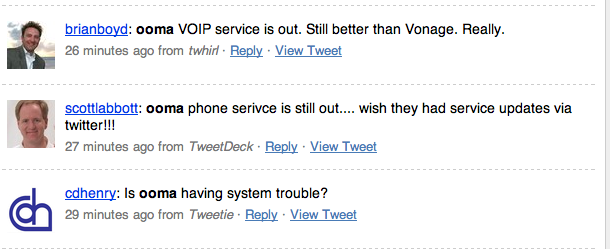 Beginning around five hours ago, Ooma users across the country began to Tweet that their service wasn’t working. Ooma technicians have been regularly posting updates to the site’s official forums, which indicates that an issue stemming from an internet outage is to blame (the company’s CMO has tweeted that “a route out of our datacenter has been severed”). Twitter users are reporting sporadic success using the service in the last few minutes, which appears to have been down entirely earlier this afternoon. Ooma has had a somewhat checkered history, struggling for years to gain market-share as consumers largely scoffed at its high pricetag (the service may have been free for life, but the $400 price of admission to purchase the unit was simply too steep for most people). But more recently, the company has been on the rebound after lowering its price to $250 per unit and closing a third round of funding last September. Update: CMO Rich Buchanan has left the following comment below:
Update 2: As of 5:15 PM PST, Ooma reports that its service is back to normal. 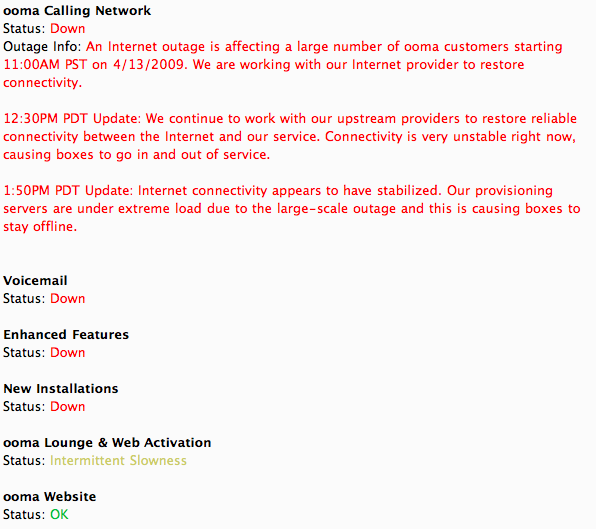 Crunch Network: CrunchBoard because it’s time for you to find a new Job2.0 |
| Reminder: Take All Your Data Out Of Kwiry Before It Sinks Into The Deadpool Posted: 13 Apr 2009 03:12 PM PDT
When SMS reminder service Kwiry launched back in December, 2007, I wondered whether anyone would use it. We now have our answer: not enough people to keep it going. The company sent out a notice today to users, also on its Website, that it will be shutting down on April 23, 2009. Kwiry allowed you to text a keyword from your phone and get back an email with links to search results for that keyword. It was supposed to be a simple way to remind yourself of things. Later, it expanded to other ways to use SMS, such as to update your Netflix movie lineup. But it didn’t really solve a pressing problem. There are easier ways to remind yourself of something than sending yourself a search results page via clunky SMS. The bigger issue I think was that these reminders were for yourself instead of being aimed at other people. People don’t want to talk to themselves, they want to talk to other people, which is why communication-based services always have an easier time gaining traction. The founders wrote a farewell note on their Website today saying:
At least Kwiry is doing the right thing by letting users take their data out of the system before the servers get turned off. Crunch Network: CrunchGear drool over the sexiest new gadgets and hardware. |
| Currently In Trouble: After Pulling Its IPO, Current TV Loses CTO Posted: 13 Apr 2009 02:42 PM PDT
After two of its reporters were detained by North Korea in a relatively high-profile incident last month, the startup got criticized (whether justified or not) for remaining deafeningly silent over the matter even when it became clear the arrested journalists were not going to get off easily. Only last Friday we reported that the state of the economy forced Current Media - often referred to as Current TV - to pull its $100 million IPO. Today, word got out that the company has lost its Chief Technology Officer Steven Blumenfeld (former VP of Technology at AOL) to a relatively unknown startup called Sparkplay Media, a venture-backed company readying the launch of a free, three-dimensional MMOG called Earth Eternal. Keep an eye on that one. We should note that Blumenfeld apparently left Current Media a while ago and joined the ranks of freelance consultants for a couple of months before joining Sparkplay and at Current was swiftly replaced by ex-Yahoo exec Ofer Shaked. It’s even possible Blumenfeld was part of the big lay-off round Current did last November, when the company slashed 60 jobs and dropped its staff to about 400 employees, although his LinkedIn profile suggests he left prior to that. Founded in 2005, the startup raised relatively little to get started ($15 million) but ultimately launched as a cable TV network/online media outlet after acquiring Newsworld International for reportedly close to $80 million. When it filed for the - now pulled - IPO in the beginning of last year, it quickly became clear that the company was burning money fast and revenues were below par. Since then, the company has been fairly silent about its financial health, and the canceled IPO has likely dealt it another blow after the job cuts late last year. Judging by its website traffic, at least according to Compete and QuantCast, its audience seems to be shrinking fast. Both peg the visitor rates to have dropped significantly since peaking in November last year, estimating it received less than half the visitors on its website than it did 6 months ago.
Crunch Network: CrunchGear drool over the sexiest new gadgets and hardware. |
| StumbleUpon Beats Skype In Escaping EBay’s Clutches Posted: 13 Apr 2009 01:34 PM PDT
The new company is led by co-founder Garrett Camp, who now steps into the CEO role. Co-founder Geoff Smith also joins Camp in returning to lead the company, but in an unannounced role. The company is backed by Sherpalo Ventures, Accel Partners, and August Capital. David Hornik from August Capital and Sameer Gandhi of Accel Partners join the board. “The company is amply funded. And everyone is glad that the company is away from eBay,” a source tells us. eBay had previously been looking for a minimum of $75 million for StumbleUpon. It’s likely the spin out valuation was significantly lower than that. Our understanding is that Sequoia placed a competing bid, but Camp and investor Ram Shriram went with Accel and August Capital. It’s not clear if eBay maintains a stake in the company, but that seems fairly unlikely. Really, its interest in the company never made a lot of sense in the first place. StumbleUpon is a way for users to find interesting sites throughout the web. While eBay certainly could have used that technology to find interesting things on its site, it never did that. And StumbleUpon’s traffic has been falling in the past year. In February 2008, the site was at 2.6 million unique visitors. But in February 2009 that number was down to 1.4 million, according to comScore (chart below). Of course, traffic numbers are a bit odd to use with StumbleUpon because the service doesn’t require that you visit its actual site if you use its popular web browser toolbar. But last year it launched a frame-based toolbar that kept you on the StumbleUpon domain in a way similar to what Digg is now doing with the DiggBar. Similarly, just as the DiggBar allows users to shorten URLs, StumbleUpon had been working on a way to do this using the Su.pr domain. This news comes at a time when reports are circulating that VoIP company Skype’s founders are also trying to rip it back out of the hands of eBay. That may be a bit more complicated as eBay bought Skype for a cool $3.1 billion back in 2005. In its former life as a startup, StumbleUpon raised a $1.5 million seed round of funding in December of 2005.
Below find the press release:
Crunch Network: CrunchGear drool over the sexiest new gadgets and hardware. |
| You are subscribed to email updates from TechCrunch To stop receiving these emails, you may unsubscribe now. | Email delivery powered by Google |
| Inbox too full? | |
| If you prefer to unsubscribe via postal mail, write to: TechCrunch, c/o Google, 20 W Kinzie, Chicago IL USA 60610 | |
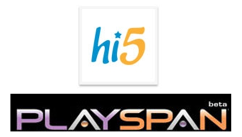 San Francisco-based
San Francisco-based 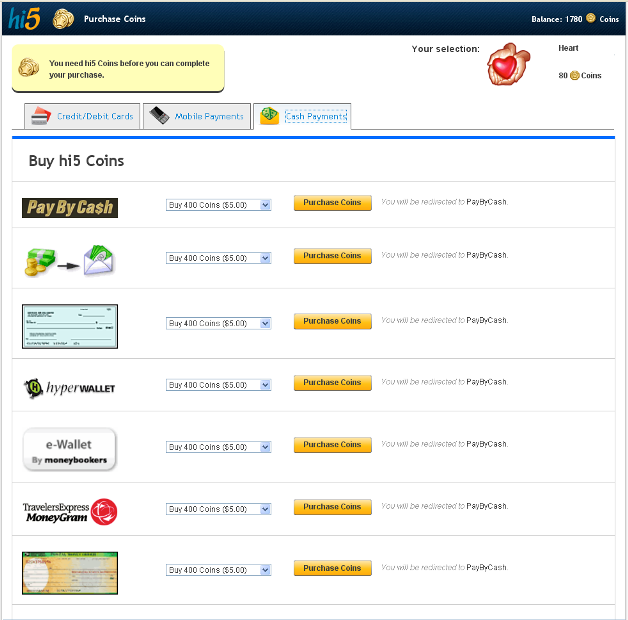
 If you’ve been using the recently released Google Earth 5.0 to check out what the oceans look like from beneath the water surface (tip: use the
If you’ve been using the recently released Google Earth 5.0 to check out what the oceans look like from beneath the water surface (tip: use the 







 As I wrote in my
As I wrote in my 
 While a lot of people may mostly be using their iPhones to
While a lot of people may mostly be using their iPhones to 

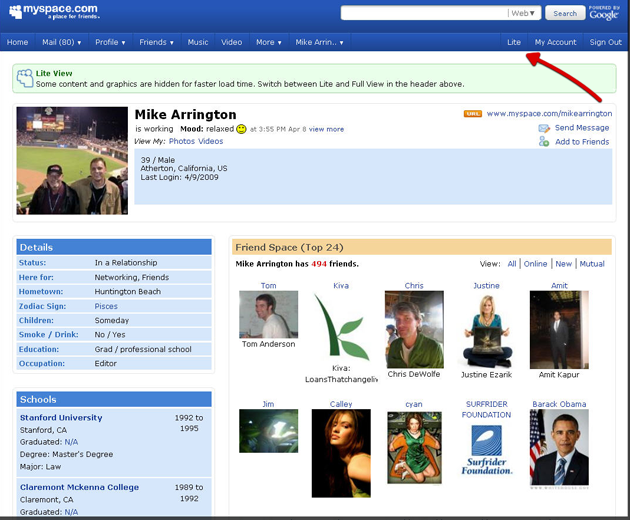
 Roger McNamee and I have two things in common. One: I desperately need a haircut. Two: I've officially given up on the dream of one-device-that-can-rule-them-all.
Roger McNamee and I have two things in common. One: I desperately need a haircut. Two: I've officially given up on the dream of one-device-that-can-rule-them-all.

 Apparently, actor Ashton Kutcher woke up today and realized
Apparently, actor Ashton Kutcher woke up today and realized 




 Back in September, we reported that eBay was
Back in September, we reported that eBay was 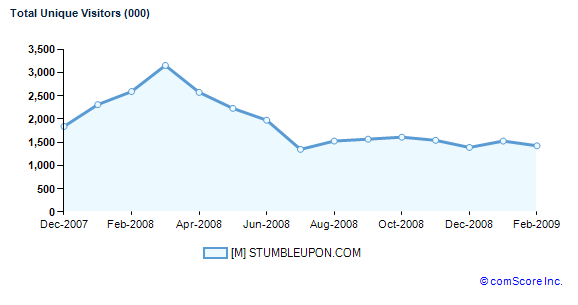
No comments:
Post a Comment